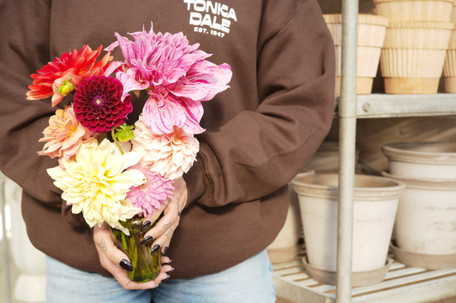Dahlia Lifting and Dividing
Posted by Amaya Fairbanks on Oct 5th 2025
Dahlia Lifting and Dividing
Dahlias are easy to grow, and come in a full range of amazing colors, shapes, and sizes. Their showstopping blooms and endless variety are a must in bouquet production. They are basically unmatched in terms of production and are a great addition to any cut flower garden. They flower from mid-summer until the first fall frost, and they produce both blooms and tubers so abundantly that they always end up getting shared. Once you’ve been bitten by the dahlia bug, there’s no going back!
About Dahlias
Dahlias are a tuber and are classified as a summer or tender bulb, a general term that includes true bulbs, corms, tubers, rhizomes and tuberous roots. Tender bulbs are planted for summer blooms and lifted in the fall as they are not sufficiently hardy to survive through winter temperatures. To read about lifting other summer bulbs, click here!
Dahlias bloom well into the fall, so be patient waiting for those flowers in August and September. They will be one of the last flowers in the fall garden. If you are planning on saving your tubers from year to year, you can increase your stock rapidly by digging and splitting. When a fall frost looms in the forecast, typically around mid-October, consider preparing to dig up or "lift" your tubers.
Lifting Dahlias
Begin by gathering up your Dahlia's ID label and untying the stalks & stems from their support system (if applicable). Cut off the main stalk about 6 inches above the soil level. Dig wide! Start far outside of where you think the tuber actually is. A damaged tuber is generally not save-able, so it's best to be overly cautious. After gently lifting the tuber, set it aside with its matching label. At this point you can gently brush off the dirt with your hands or a soft brush. Shake free all dirt from the tuber, and gently rinse in a tub or with a hose. We want to clean the dirt off, but do not want the tuber to stay wet. After cleaning off, the tubers should be dried for 4-8 hours to cure them. They should never be cured for more than one day, as a shriveled & dried out tuber will not be viable. It’s best to cure your tubers in a temperature controlled area away from sun or wind, so curing indoors is likely the easiest way to do this. You can dry them on a rack, on a towel, or on some newspaper.
Dividing Dahlias
Dahlias can be divided with a clean (sanitized) pair of shears or sharp scissors. There are a few important things to consider: Each tuber will need to be attached to a piece of the main stem, or the “neck” of the plant. Also, each individual tuber will need an eye to produce in the spring. It can be difficult to identify each eye on tubers in the fall, but they will become more visible in the spring and may even begin to push a green shoot. Good practice is to save all tubers and discard any that lack eyes in the spring. Each tuber will be shaped uniquely, and you must make a different choice per bulb about where and how to cut them apart. Some are easily split into several tubers, and some are so tangled that storing them whole may be the best option. Broken pieces or tubers that are damaged are not viable.
Storing Dahlia Bulbs
Once clean and relatively dry, Dahlias are best stored wrapped in plastic wrap. This method is advised by the National Dahlia Society. Roll each individual tuber in plastic wrap, adding another tuber of the same type as you go. The layers of plastic wrap keep the tubers from drying out, and also ensure that if one tuber rots that it will not affect the others. Be sure to label your tubers after they are all bundled up!
Place your labeled tubers in an open box and store them in a basement or closet, where it is dark, cool, and dry. Ideal temperature is 45F-50F. We recomend checking in on them a few times throughout the winter, so that you can make adjustments if needed. If a rotten tuber is found in this process, toss it out. If you find that some are dried or shriveled, you may either keep an eye on them or choose to discard them as they aren’t always viable.
Think Spring
In the spring, Dahlia tubers begin to push out eyes, which are small buds where the plant will grow from. If a tuber does not have an eye it is not viable, but many tubers will have multiple eyes. If any were stored as whole tubers in the fall, now is the time to split them. As a reminder, each split needs three things: a tuber, an eye, and part of the neck. You could also plant the tuber whole if desired.
Taking a little bit of time in the fall to lift, divide, and store your dahlias is not only cost-effective but incredibly rewarding! You can easily multiply your stock every year with these simple preservation tips.

